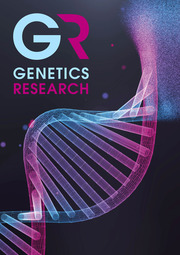Crossref Citations
This article has been cited by the following publications. This list is generated based on data provided by
Crossref.
Bradshaw, Rosemary E.
El-Mesillati, M.
and
Peberdy, J.F.
1983.
Genetic analysis in Aspergillus rugulosus using the parasexual cycle.
Transactions of the British Mycological Society,
Vol. 81,
Issue. 1,
p.
15.
Bhatnagar, D
McCormick, S P
Lee, L S
and
Hill, R A
1987.
Identification of O-methylsterigmatocystin as an aflatoxin B1 and G1 precursor in Aspergillus parasiticus.
Applied and Environmental Microbiology,
Vol. 53,
Issue. 5,
p.
1028.
Beremand, Marian N.
and
Desjardins, Anne E.
1988.
Trichothecene biosynthesis inGibberella pulicaris: Inheritance of C−8 hydroxylation.
Journal of Industrial Microbiology,
Vol. 3,
Issue. 3,
p.
167.
Bennett, J.W.
and
Papa, K.E.
1988.
Genetics of Plant Pathogenic Fungi.
Vol. 6,
Issue. ,
p.
263.
Payne, Gary A.
and
Woloshuk, Charles P.
1989.
Transformation ofAspergillus flavus to study aflatoxin biosynthesis.
Mycopathologia,
Vol. 107,
Issue. 2-3,
p.
139.
Bhatnagar, Deepak
Cleveland, Thomas E.
and
Lillehoj, Eivind B.
1989.
Enzymes in atlatoxin B1 biosynthesis: Strategies for identifying pertinent genes.
Mycopathologia,
Vol. 107,
Issue. 2-3,
p.
75.
Woloshuk, C P
Seip, E R
Payne, G A
and
Adkins, C R
1989.
Genetic transformation system for the aflatoxin-producing fungus Aspergillus flavus.
Applied and Environmental Microbiology,
Vol. 55,
Issue. 1,
p.
86.
Chuturgoon, Anil A.
and
Dutton, Michael F.
1991.
The Affinity Purification and Characterization of a Dehydrogenase fromAspergillus parasiticusInvolved in Aflatoxin B1, Biosynthesis.
Preparative Biochemistry,
Vol. 21,
Issue. 2-3,
p.
125.
Keller, Nancy P.
Cleveland, Thomas E.
and
Bhatnagar, Deepak
1992.
Variable electrophoretic karyotypes of members of Aspergillus Section Flavi.
Current Genetics,
Vol. 21,
Issue. 4-5,
p.
371.
Garcia, Marta‐E.
and
Suarez, Guillermo
1993.
Comparison of the Use of UV Light and Nitrosoguanidine as Mutagenic Treatments in Aspergillus parasiticus.
Journal of Veterinary Medicine, Series B,
Vol. 40,
Issue. 1-10,
p.
378.
Ushijima, Shigeomi
1994.
Aspergillus.
p.
41.
Cotty, P J
and
Bhatnagar, D
1994.
Variability among atoxigenic Aspergillus flavus strains in ability to prevent aflatoxin contamination and production of aflatoxin biosynthetic pathway enzymes.
Applied and Environmental Microbiology,
Vol. 60,
Issue. 7,
p.
2248.
Foutz, Kirk R.
Woloshuk, Charles P.
and
Payne, Gary A.
1995.
Cloning and assignment of linkage group loci to a karyotypic map of the filamentous fungusAspergillus flavus.
Mycologia,
Vol. 87,
Issue. 6,
p.
787.
Bos, C. J.
and
Swart, K.
1995.
Genetics and Biotechnology.
p.
19.
Woloshuk, C P
Yousibova, G L
Rollins, J A
Bhatnagar, D
and
Payne, G A
1995.
Molecular characterization of the afl-1 locus in Aspergillus flavus.
Applied and Environmental Microbiology,
Vol. 61,
Issue. 8,
p.
3019.
Widstrom, Neil W.
1996.
Vol. 56,
Issue. ,
p.
219.
Prieto, R
Yousibova, G L
and
Woloshuk, C P
1996.
Identification of aflatoxin biosynthesis genes by genetic complementation in an Aspergillus flavus mutant lacking the aflatoxin gene cluster.
Applied and Environmental Microbiology,
Vol. 62,
Issue. 10,
p.
3567.
Prieto, R
and
Woloshuk, C P
1997.
ord1, an oxidoreductase gene responsible for conversion of O-methylsterigmatocystin to aflatoxin in Aspergillus flavus.
Applied and Environmental Microbiology,
Vol. 63,
Issue. 5,
p.
1661.
Payne, G. A.
and
Brown, M. P.
1998.
GENETICS AND PHYSIOLOGY OF AFLATOXIN BIOSYNTHESIS.
Annual Review of Phytopathology,
Vol. 36,
Issue. 1,
p.
329.
Moreno, O. J.
and
Kang, M. S.
1999.
Aflatoxins in maize: The problem and genetic solutions.
Plant Breeding,
Vol. 118,
Issue. 1,
p.
1.

